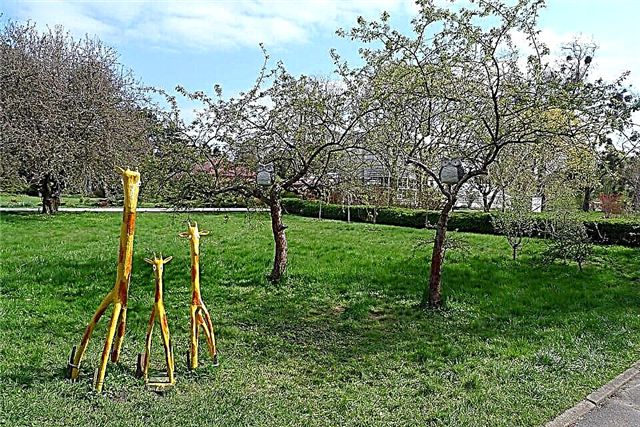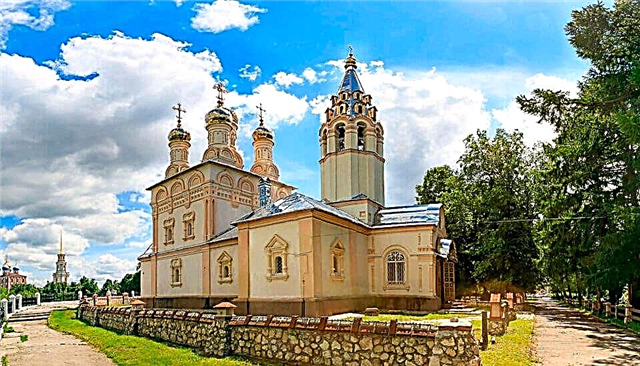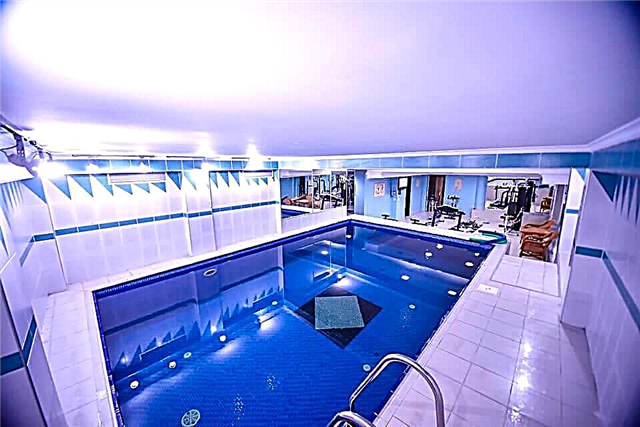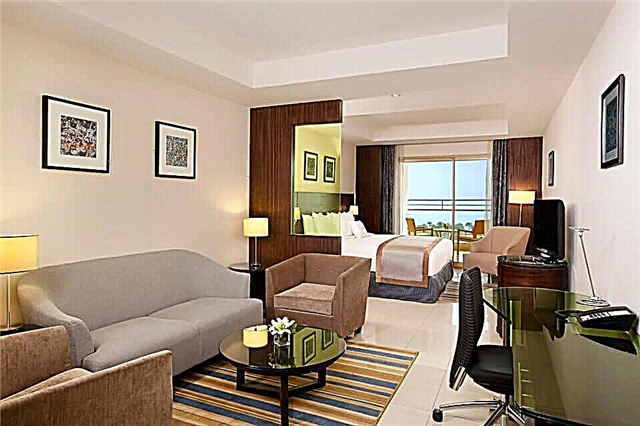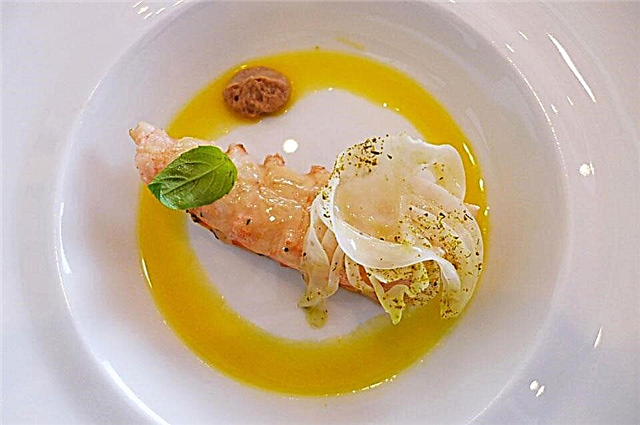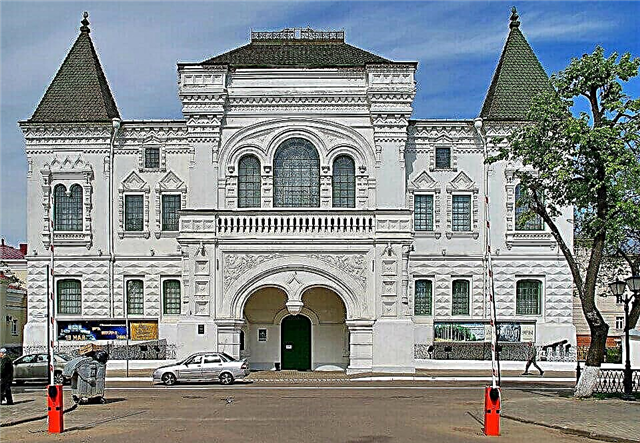Kostroma is an old merchant town. There was an intensive trade in a wide variety of goods: after all, Kostroma stood on the Volga, a large and full-flowing river of Russia. The city is the patrimony of the Romanov boyars. Even during serfdom, local peasants were considered the sovereign's people. The cultural life was in full swing here. It was in these places that the playwright Ostrovsky invented his Snow Maiden, and Fyodor Volkov founded the first theater. The wonderful nature attracted artists. The Kostroma land gave birth to talented artisans. Jewelers from Krasnoye Selo, potters from Dymkovo and Petrovo still delight people today. And the museums of Kostroma will acquaint you with the history and traditions of the modern province.
Terem of the Snow Maiden

Today, any student can easily answer the question of where the Snow Maiden was born. Of course, in Kostroma. More precisely, in the Shchelykovo estate. It was here that the Russian playwright Ostrovsky described the love story of a Slavic goddess and an earthly youth. The modern Snegurochka welcomes guests all year round. In her mansion, order is maintained between the Brownie and his wife Domovikha.
The territory is not guarded by the evil cat Bayun. The same fairy-tale characters, together with the hostess, conduct excursions and organize festive events. Time flies by in the mansion. Guests participate in folk amusements, sing songs. And what a Shrovetide at the Snow Maiden! Not only delicious pancakes will be remembered, but also traditional attractions. And during Ivan Kupala, visitors will feel the magical spirit of the July night.
The Ice Room is unusual. In it you can take pictures with ice fairy-tale characters, taste drinks. Children are eager to try a snow cocktail, and adults - something stronger, poured into glasses of ice.
Kostroma Sloboda

The oldest architectural reserve in Russia. Buildings in the Kostroma province were traditionally erected from wood. And the famous technology of joining parts without a single nail was used here as well as in Kizhi. The builders carefully selected the material, so the huts, baths, barns, chapels and churches have been perfectly preserved. It is not surprising that local historians of the Kostroma land had an idea: to combine all this in one place. This is how the ethnographic and architectural center appeared.
Each county had its own building traditions: the artel workers carefully kept their secrets and did not give out to competitors. But now we can enjoy the view of different buildings. No wonder they say: each village has its own custom. Each building is filled with items of peasant life. Here you can see spinning wheels, kitchen and dining utensils, pottery wheels. Chapels and village churches contain church utensils.
But the most important thing is entertaining stories told by the guides. The staff of the reserve will acquaint guests with the traditions of Russian wooden architecture, with what other natural materials were used in the old days. Festive events are also held on the territory of the center.
Historical-Architectural and Art Museum-Reserve

The first museums in the city appeared at the end of the 19th century. At first, it was a place where artifacts were collected and stored; citizens' access to storage units was prohibited.
The exhibits came in 2 ways:
- local scientists worked with archives, carried out excavations
- additionally donations from citizens were accepted
Over time, a significant collection has accumulated, and the question arose of where to store and display it for inspection. Only in 1891 was the premises received in the building of the Noble Assembly on Pavlovskaya Street.
Today the center consists of:
- Romanov Museum
- department of nature
- Museum of the history of the Kostroma region
- fire tower
- picture gallery
- guardhouses
- Kostroma settlement
- museum and exhibition center
In addition to permanent exhibitions, the administration of the center organizes thematic ones.
Museum "Provincial town of Kostroma"

The main occupation of the Kostroma people before the October coup was trade. Therefore, the exposition is located in the pavilion of the Trade Rows. These shops were built in the 19th century. Here the merchants of the city exhibited samples of goods, made deals. The interiors of the center are original. Visitors will see old brickwork, vaulted high ceilings, thick walls. The halls are located one behind the other: this is typical for the sale of small goods. But today the guests will get acquainted not with product samples, but with how the business was organized in the city as a whole.
Separate stands are dedicated to:
- famous merchant surnames
- advertising that successfully developed at that time
- the first booklets and business cards used by merchants to promote products
- samples of small goods
The organizers of the center decided to acquaint visitors with the history of temples and the bell foundry founded by Serapion Zabenkin. Guests are happy to stop at a display case with bells that were hung on arcs for a fun ride. Collections of antique glass and tableware are also on display. But there is another interesting room. It displays works of contemporary artisans and artists of the city. Products can be purchased, and then try a wonderful drink from a barista in a local cafe.
Museum of the history of the kostroma region

An excellent place for those who want to get to know the Kostroma region. Here are the sections from the first settlers and colonization of lands to our time. A separate exposition dedicated to the Romanovs and Godunovs is organized. The tour begins from the hall, where finds are displayed, describing the life of the first inhabitants of the region. Artifacts were found on the island of Vezha. And then the guests move on to the stands of the Romanovs and Godunovs.
Here are the genealogical trees of the side branches of the Rurikovich family, priceless documents, photographs of the last members of the family. An important stage in the life of the province was the October Revolution. The hall shows maps of counties and townships. In order to avoid peasant unrest, the lands of the outskirts of Kostroma were united with the territories of the Nizhny Novgorod province.
The exposition contains household items of nobles. Artifacts from the estate of Tropinin, Burygin were transferred here. The collection is constantly updated. Negotiations are underway to transfer paintings from the personal collection of Valery Babkin. But the permanent exhibition is not the only thing that attracts the center. It hosts thematic exhibitions, lectures, interactive compositions, meetings with interesting people. The employees and the administration make sure that guests come here again and again.
Romanov Museum

The center is small, so it will take a little time to see. And you should start by studying the building. It looks like a white tower or a gingerbread house, and was built specifically for the 300th anniversary of the house of the last Russian emperors. The provincial city was often visited by members of the imperial family. It was visited by Catherine the Great, Pavel Petrovich, Alexander 1, Alexander 2, Alexander 3, Nikolai 1. Sovereign Nikolai Alexandrovich came to the opening with his family.
The first exhibits were presented by the State Archival Commission of the city. But a significant part of the exhibition was devoted to the history of the house. That is why the center got its name. The 300th anniversary in the city and the province was celebrated on a large scale: the pedagogical institute and the hospital were additionally rebuilt. Therefore, the ensemble was called the cradle of the House of Romanov. For the construction of the ensemble, wealthy citizens collected money by subscription, and the project was additionally financed from the state treasury.
Guardhouse

The building was actively used from the middle of the 19th century to the beginning of the 20th century. Here there was a guard and a room for the military serving sentences (the guardhouse itself).
According to the opinions of the townspeople of that time, the conditions of service were unimportant:
- there were holes in the floor where the guard was located, through which rats penetrated
- the latrine was not disinfected, there were sharply smelling puddles on the floor
- the windows are dirty
- there was no tank for boiling water
- the guard officer was forced to inhale poisonous fumes
During the reaction of 1909-1911, prohibited literature was found in the premises of the lower ranks. But the investigation did not lead to anything. In front of the building there was an asphalt area where a sentry was on duty. And the townspeople were forced to bypass it through mud and bumps. Before the festive events dedicated to the 300th anniversary of the House of Romanov, a sidewalk was laid around.
The Kostroma residents applied to the council to close the guardhouse and place a public library in the building. But the petition was rejected. In Soviet times, the building was used as a children's library, registry office, and museum departments. Today, tourists admire the amazing building for a long time, which is part of the architectural ensemble of the historical center of the city. In the very same guardhouse there is a military-historical exposition.
Assembly of the nobility

The exhibition attracts those tourists who are interested in the life of local nobles. It received its first visitors in the 90s of the 19th century.
Today you can learn about:
- the interests of the cream of Kostroma society, their merits and vices
- elections of the leaders of the nobility
- governors and officials of pre-revolutionary times
- congresses of nobles
- life and work of Efim Chestnakov, artist
But in the Assembly of the Nobility, thematic events are also held. Invitations to the annual New Year's ball are distributed long before the event. Exhibitions dedicated to families whose life is connected with the Kostroma land are organized. For this, documents from personal archives are used. Theatrical performances, meetings with famous Kostroma residents are often organized. Parents and adults alike actively attend master classes by local artisans.
Shopping arcade

The architectural complex was rebuilt at the beginning of the 19th century. Earlier in this part of the city there was a lower settlement. The buildings were wooden, so the great fire of the late 18th century almost completely destroyed them. The city authorities decided to build a shopping arcade. Each line included shops selling the same product. Fish were traded in fish farms. By the way, there were also live fish rows. The townspeople came here for live river fish.
Over the years, the rows were rebuilt many times: some buildings were dismantled in order to use bricks for urban needs. But the fish were lucky: they survived almost intact. And today, guests are happy to inspect the building of late classicism. Inside you can see the original stonework, the floors divide a single room into rooms in which the benches were located.
Each section had a basement for storing goods and a second floor for office supplies. Visitors were served on the ground floor. Today there is an art gallery in the Rybny Rows. Here are the canvases of contemporary artists. There are also art studios for people of different ages, master classes are organized.
Fire Tower

The city was built from the most accessible local material - wood. Unfortunately, the distance between the buildings was negligible, so the city often burned. And it was not at all uncommon when entire areas were burned to the ground. In 1825, the governor of Baumgarten ordered the construction of a stone watchtower to replace the regularly burned fire towers. The project was developed by the talented architect Fursov. He decided to create a unified style for Susaninskaya Square. The building was visible from every part of the city. Residents from all parts of the city came to admire the patterned building.
The tower included:
- fire tower
- supply rooms (later than cars)
- sheds for storing barrels of water
- guard room
- living quarters for fighters
A sentry was on duty at the tower all day and night. And balloons served as a signal: red was released if the center was on, blue - the outskirts. At night, the balls were replaced with white and red lanterns. Additionally, a sound signal was given: the bell was ringing. Today, tourists can not only inspect the wonderful building from the outside: the most interesting fire-fighting museum is located inside. Kalancha is included in the UNESCO heritage list.
Museum "Les-miracle worker"

This is a modern exposition, the creator of which has set a goal: to teach adults and children to respect the main gift - the forest. For the reception of guests, a manor was built on the banks of the river. It is surrounded by a living hop fence that beautifully braids the hedge. In summer, logs are practically invisible under thick foliage. And Natalya Zabavina turned the yard into a forest area. All the plants characteristic of the region have been planted here. And under tall spruce and birch trees, guests are greeted with sculptures made of wood, branches, vines and roots.
Here you can meet the goblin who guard the forest and its inhabitants. Tourists get to know the forest from an unusual perspective: it is a healer, protector, a source of life not only for animals, but also for humans. Additionally, guests are invited to participate in workshops organized by local artisans. You can learn to weave from a vine, carve wood, paint products.
Museum of jewelery art

The first jewelry was made here as far back as BC. This is evidenced by the finds of archaeologists. And the formation of the craft took place in the 14-16 centuries. At this time, dynasties of jewelers were formed in the villages. The heyday of the jewelry business came at the end of the 19th and the beginning of the 20th century. At this time, the products of the masters of the village of Krasnoe could be found in peasant huts, merchant houses, and royal mansions.
Jewelers adorned churches and monasteries, their works are presented in museums. In Soviet and post-perestroika times, the craft did not die out: jewelry made of gold, silver with traditional filigree was readily purchased not only by ordinary citizens, but also by those in power. Therefore, the idea to create an exposition dedicated to the primordial Kostroma craft was in the air.
Not only jewelers took part in the organization. It was necessary to involve scientists, archaeologists, artists. And the building was selected as a unique one: an architectural monument of the 19th century, located in the historical center. Having come here, guests will get acquainted with the history of the names of jewelers, see old photographs, documents, samples of works made of gold and silver using traditional techniques.
Museum "Fairy Land of the Snow Maiden"

Who will tell you about the Kostroma land most fully? Of course, her native is Snegurochka. The fairy-tale land of the Snow Maiden is located in the center of additional education Istoki. The polite Snow Maiden meets tourists on the doorstep and escorts them to her chambers. Her house (as Ostrovsky wrote) is an ordinary peasant hut. But everything that surrounded the farmers is represented in it. And the hospitable hostess will tell about the traditions of the peoples who settled here, their way of life and amusements.
The center exhibits both original household items and reconstructed ones. Folk costumes were specially made for the exhibition: they are dressed up with dolls from the collection of Margarita Artamonova. You can just see the people's gallery, or you can book an excursion, take part in master classes. Time in the Snegurochka's Fairy Land flies by unnoticed.
Museum-Estate of Flax and Birch Bark

Another brainchild of a creative resident of the city Natalia Zabavina. She came up with the idea to combine in one exhibition what the province has long been famous for: flax and birch bark. In order to accommodate the exhibits, a separate house was built, stylized as a fairytale house. And in the courtyard they organized a cozy corner with a lawn, a bridge over a stream and a flower garden and a well. Guests do not come to the exhibition, but immediately into the fairy tale.
The exposition occupies several rooms:
- In the flax hall, the whole process of turning raw materials into shirts for peasants is presented. The guide describes in detail all the stages.
- Sculptures of fairy-tale heroes are exhibited in the birch bark hall.Children stay near them for a long time. It is impossible to believe that not only the usual baskets and tuesa, but also the pistons were made of ordinary birch bark.
- Hall for master classes. It is decorated with works of local craftsmen: canvases, tablecloths, napkins, rusks, bread bins.
- A hall where you can buy souvenirs for memory.
Surprisingly: the presented linen sundresses are fashionable and perfectly worn, and birch bark napkin makers organically complement the interior of the dining room.
Museum of Nature of the Kostroma Region

The exposition consists of almost 3500 items. And it is located in the historic center, the building of the former Sobriety Society and Commercial Exchange.
Several permanent exhibitions have been organized:
- In the Spring pavilion, guests will see dioramas depicting the current of black grouses and the games of wood grouses. The shore of a forest lake with its inhabitants has been reconstructed. But the most popular exhibit is the bear.
- In the Winter hall, it is shown how the inhabitants of the forests are hiding from the bad weather, looking for food. Exhibition center: a diorama showing the hunting of a moose by a pack of wolves.
- Guests are interested in a stand with a description of flora and fauna. The decoration of the exposition is the collection of the entomologist Rubinsky.
- Paleontological finds are exhibited in the Stone Chronicle Hall of the Kostroma region. They were found at different times on the territory of the region. The topic of the mysterious Mesozoic is presented separately.
- An interesting exhibition Food underfoot. Guests suddenly learn that common weeds can serve as complete sources of vitamins and nutrients.
There is a petting zoo. Here you can watch the smaller brothers immersed on Noah's ark. Thematic events are held separately.
Museum of unique dolls and toys

This is a small private exhibition, occupying only 3 rooms. It was organized by Nadezhda Sheiko. Nadezhda has been collecting toys for 30 years. The core of the exposition is Soviet toys. Once they were produced in abundance by the light industry of the USSR.
Here are:
- dolls
- bears
- soldiers
- rubber toys
- toy furniture
- dishware
The toys are in excellent condition, but their outfits have been reconstructed. But some of the dolls made in the 19th century have original dresses. This is the ideal place for those looking for a meeting with a long-gone childhood.
House of Malyshev M.M.

Malyshev's house is interesting, first of all, by the personality of its owner. In 1915, a peasant living in the village of Dvorishchi received the personal title of an honorary citizen of the city. The house was acquired by him long before this event: in 1901. At first, the acquired building was a tenement house, and then it became a shelter for the Consumer Society. Today, the organizers of the center have done everything to make the guests feel the spirit of recent times when they come here.
Exhibited here:
- kitchenware
- sewing machine
- tailor's scissors
- elements of the artist's workshop
Those interested can attend a master class on embroidery. And small companies can stay here. The owners of the center own a small guest house Yablonevy Sad. The hotel is designed for a group of up to 8 people.
Bread museum

The exhibition is located in the Big Flour Rows. At first, an ecological Grain bakery settled here. Its products fell in love with residents and guests of the city, so the organizers decided to create a museum of bread. Visitors actively participate in the excursion. Competent presenters talk about local baking traditions, show dough samples, explain how to germinate grain correctly to obtain bread fortified with vitamins.
The culmination of a visit to the center is a tasting of the bakery products. It is served with a treat from the owners: honey, jam, tea, sunflower oil, sbitn, herbs, fruit drink and even Thursday salt. The guests also participate in unusual master classes. It is proposed to make a doll-amulet Zernovushka, mold a figurine from salt dough, paint a gingerbread. Time in such classes flies by quickly.
Cheese museum

Kostroma is the capital of cheese. Here a unique breed of dairy cows originated, therefore the products are of high quality. And the cheese exhibition is so popular that it is recommended to book an excursion 2-2.5 weeks in advance. The story is extremely entertaining for adult visitors. Children are frankly bored. They are a little entertained by rolling out the cheese head, milking the cow (plastic, of course). But the tasting delights everyone.
Passionate sommeliers not only explain how the milk for cheese is fermented and how it ripens, but also advise to use the delicate product correctly. After the excursion and tasting, the guests go to the cheese shop. Here, all the cheeses produced in the city are cut into small cubes and vacuum packed. It is convenient: several types of products can be purchased. But prices are slightly higher than on the cheese exchange.
Museum of theatrical costume

Over the years of its activity, the drama theater has accumulated enough costumes. Many of them are unique: they are made from fabrics that are not currently being manufactured. Thanks to the efforts of dressers and restorers, the condition of the outfits is excellent. The center began its work with a small exhibition organized by the theater administration. The interest of the townspeople in it was enormous: it became clear that it was necessary to create a permanent exhibition. The first visitors appreciated the collection in 2005. Among them was V.V. Putin. But inspecting the collection was inconvenient: it was dispersed on all floors of the theater.
Therefore, in 2010, the city authorities allocated a building in the historical center of the city for the permanent exhibition. The building itself is amazing: the organizer of the drama theater Fyodor Volkov was born in it. Today the exposition occupies 7 rooms, where more than 100 costumes are presented. Guests can inspect the outfits on their own or with a guide, take pictures in amazing dresses. Interactive events are held for children by appointment.
Museum of the Kostroma merchant

The organizers of the exhibition fulfilled their task perfectly: they completely recreated the merchant life. The exposition occupies several sites:
- In the malls there are samples of goods for which the city was famous. But how can you do without commercial equipment? And it is presented here! In ancient times, a unified system of measures and weights did not exist yet. Therefore, for fair trading, accurate scales with weights (weights) were required. Guests will see equal and multi-shoulder scales, scales with a movable weight.
- And how did the merchants deliver the goods to the point of sale? Of course, with the help of cargo sledges and carts. On the sled yard, visitors will see passenger and freight horse-drawn transport of bygone days. Elements of horse harness are presented.
- After a busy day, the merchants came home. And here hospitable hostesses were waiting for them with pies baked in a Russian oven. On this site, a hospitable hostess will tell visitors about the importance of the stove in the life of merchants of the 19th century.
And the final part of the excursion will be a traditional Russian tea party with pies from the oven.
House of the mayor G. N. Botnikov

Gennady Botnikov held a high position for 14 years. During this time, the first telephone line appeared in the city, a public library, a labor house, and schools for city children were opened. A rich Kostroma built a mansion for himself in the center, the total area of the premises of which exceeded 350 square meters. Muscovite Nikolai Kuzovlev decided to restore the building and turn it into a museum. The house was re-plastered and the interiors were renewed while maintaining the original concept.
Household items, furniture are not original, but antique. Everything is very solid and worthy. It is noteworthy that the administration of the complex does not prohibit touching the exhibits. In the richly decorated dining room, a table set for tea awaits guests.Here visitors will not only hear a story about the life and work of Botnikov, but also learn secular news and fresh (a century ago) gossip. And in addition, you can order one of the entertainments for which the city was famous a century ago. This is interactive fortune telling.
Museum "Petrovskaya Toy"

Petrovskaya toy (ocarina) is a national treasure of the region, an ancient musical instrument. It is easily recognizable by its brownish green color. It is not surprising that they decided to immortalize the ocarina on the Kostroma land.
The exhibition occupies 3 halls:
- Dedicated to the ocarina proper. Here the masters will tell how the whistle was made from local clay, how it was given a sound in a certain key, how it was decorated with a characteristic ornament.
- Dedicated to other folk toy crafts. In it, guests will get acquainted with toys from Dymkovo, Filimonov, Skopin, Kargopol. These villages have developed their own traditions of making clay figurines.
- Master class hall. Here guests gain experience of working on a potter's wheel. If desired, they will make a toy, ocarina, jug, plate or cup. After hardening and firing, the item can be taken with you and used at home.
There is a souvenir shop where visitors can buy products from local potters.
Museum of Gypsy Culture and Life

This place is a must-see for lovers of ethnography: after all, such a center is the only one in Russia. Gypsies are many-sided people. Its representatives are scattered all over the world. Wherever the gypsies appeared, they immediately absorbed local customs. That is why the traditions of the people are intertwined with Slavic traditions. Russians believe that Valenka's song, performed by Lydia Ruslanova, is composed by the people. Undoubtedly, but how exactly? Gypsies claim that this is an old dance camp.
And the gypsy Nastya Polyakova sang it first. How is the wedding going in the tabor? So that it turns out to be richer than the neighbor. Sometimes more than 300 people walk. And everyone needs to be met and treated with dignity. The exposition of the center tells about all this. And also the famous gypsies are presented separately: Nikolai Slichenko, Lyalya Chernaya, Lyalya Pearl and even Charlie Chaplin. Visitors will not only listen to an amazing excursion, but will also sing to the guitar along with Russian Roma.
Teapot Museum

This is the warmest exposition, literally and figuratively. Here the organizers will tell about the traditions of Russian tea drinking and the history of the appearance of the teapot, in which the aromatic drink was so appetizingly brewed. Visitors will learn that such a simple and well-known kitchen item has its own secrets. And in order not to be unfounded, the hosts will offer guests fresh tea with local sweets - the famous waffles.

